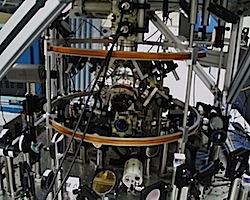What have we learned from the LightSquared fiasco?
Aside from the fact that someone gambling with other people’s money, with friends in high places benefiting from his largesse, can make the law stand on its head and our hair stand on end.
But then, we already knew that.
Just because the forces behind the broadband cellular company, Philip Falcone and Harbinger Investments, made their money by betting against the housing bubble doesn’t take away from the fact that they represent the same crew who helped take down the world economy in 2007.
What have we learned from the LightSquared fiasco?
Aside from the fact that someone gambling with other people’s money, with friends in high places benefiting from his largesse, can make the law stand on its head and our hair stand on end.
But then, we already knew that.
Just because the forces behind the broadband cellular company, Philip Falcone and Harbinger Investments, made their money by betting against the housing bubble doesn’t take away from the fact that they represent the same crew who helped take down the world economy in 2007.
People who use other people’s money to get rich off of enterprises founded on real innovation, hard work, competition, and marketplace risk are not in the same business as the latter. They aren’t even in the same economy.
It’s also not news that the Federal Communications Commission is filled with political cronies prepositioning themselves for lucrative returns to the industry they regulate.
So, have we learned anything useful from the slow-motion car wreck that is LightSquared and it’s encroachment into L-band frequencies long allocated for other purposes? What can the GPS and wider GNSS community do to increase our preparedness for the next attack on the hard-won equities of this wonderful public utility?
Well, the need for more effective, continuing organization and representation of the GNSS community — manufacturers, service providers, and users — seems pretty clear.
Despite the commercial availability of the GPS resource for more than 20 years, there has never been a strong awareness of the community as one involved in a mutually interdependent, on-going common enterprise.
Indeed, companies in the GNSS business often appear to consider themselves a subset of other industries — perhaps information technology, telecommunications, electronics, or mobile devices. The confusion is not surprising, given the strong vertical application markets into which GNSS products and services are sold.
But GNSS has unique characteristics that mark it as a something apart: a space-based infrastructure that is publicly owned, dual-use, and therefore possessing certain requirements regarding export of technology.
Common interests abound, and I’m not just referring to the RF issues that fuel the present furor. Already, some in Congress seem to be toying with the idea of requiring receiver standards that could include GPS products. In the great national deficit debate, program budgets are often laid waste — this year congressional committees have already whacked FY12 funds for GPS III and OCX space and ground segment modernization.
Multiple agencies and overlapping regulations control the export of products in any global market such as ours. The emergence of other GNSS systems raise issues of fair trade and common technical standards that promote compatibility and interoperability.
The list goes on and on.
Despite its high profile in the contest before the FCC, the U.S. GPS Industry Council (USGIC) has never represented a true industrywide entity, although many besides its members have benefitted from the council’s efforts. Over the years, the USGIC has lobbied effectively for GPS-related trade policies and helped transform multiple presidential policy directives into law.
But for all its good work, the USGIC’s self-defined mandate has limited its reach. We still need a broad-based industry association.
Such an organization would look more like the ad hoc Coalition to Save Our GPS that formed in a hurry around the LightSquared issue. The coalition claims to represent more than 100,000 companies and millions of employees, either independently or through their trade associations.
The coalition’s reach clearly extends further than its grasp, at least until now. Many of the individuals and companies included in its claim probably don’t even know of the coalition’s existence.
But the coalition has awakened and gathered a far greater number of companies and organizations with vested interests in GPS than ever before. And its role in the second or third act of the LightSquared drama could transform it from a single-issue entity into a full-fledged, permanent advocate for GPS.





